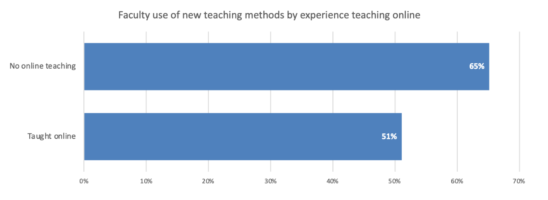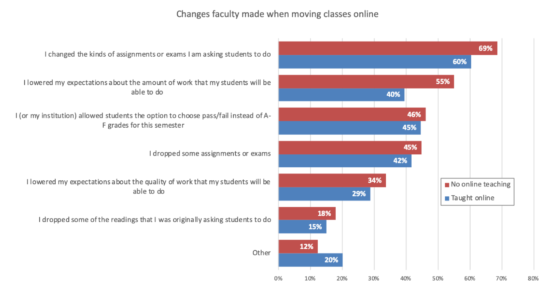Lederman, D. (2020) How Teaching Changed in the (Forced) Shift to Remote Inside Higher Education, April 22
Who did the study?
This is a report of a survey conducted by a team of researchers and U.S. organisations, and with some participation from Canadian organizations, including the CDLRA and George Veletsianos of Royal Roads University. The study is led by my CDLRA colleague, Jeff Seaman, of Bay View Analytics (formerly the Babson Survey Research Group).
The study surveyed 826 faculty members and administrators at 641 American colleges and universities this month, and included 26 professors at Canadian universities/colleges.
What did they find?
The Lederman article provides the following summary of results:
- 90 percent of instructors surveyed engaged in some form of emergency distance/virtual education to conduct or complete the spring term; those that did not were typically in colleges that already were exclusively online, or in the few areas in the the U.S. where shelter-in-place orders were not in force.
- 76 percent reported that they had to move some of their courses online to complete the term. Again, the remaining instructors were those who were already teaching fully online or whose courses were canceled or suspended because of the pandemic.
- 56 percent said they had used “new teaching methods” in transitioning their courses to remote delivery. Instructors with no previous online teaching experience were much likelier to answer that way than were their peers who had taught online before they were forced to this spring.
- experienced online instructors were less likely than their peers to use synchronous lectures or discussions and more likely to distribute information using the LMS
- almost two-thirds said they changed “the kinds of assignments or exams” they gave to students, and nearly half said they lowered their expectations for the amount of work students would be able to do (48 percent), made it easier for students to take their courses pass/fail (47 percent), and “dropped some assignments or exams” (46 percent).
- however, instructors with previous online experience were 15 percentage points less likely than their peers to lower their expectations for how much work students could do, and somewhat less likely to change the nature of their assignments to students.
- the results and open-ended comments respondents made about their experiences and their worries about the fall show the “level of anxiety and scrambling” many instructors felt during this pivot to remote learning
- But it’s also clear that despite that anxiety, institutions and instructors made significant changes on the fly in their teaching practices and expectations to try to pull off a required, if undesirable, transition this spring.
How to find out more
First let me say that only a summary of the results have been released so far, and even from these I have chosen just enough to give you some idea of what the survey covers.
If you want to know more, there is a free webinar on Friday (April 24) at 2.00 pm Eastern Daylight Time with Jeff Seaman, the lead researcher, Jennifer Mathes, CEO of the Online Learning Consortium, Will Austin, president of Warren County Community College, and Inside Higher Ed Editor Doug Lederman who will analyze the results and answer questions from participants.
What about Canada?
Although the Canadian sample was small, the results were similar for Canadian instructors.
The CDLRA plans to conduct a survey of all Canadian post-secondary institutions in the fall to identify what they did this spring, what they are doing in the fall semester, and what changes if any they plan for when institutions return to normal.











 Dr. Tony Bates is the author of eleven books in the field of online learning and distance education. He has provided consulting services specializing in training in the planning and management of online learning and distance education, working with over 40 organizations in 25 countries. Tony is a Research Associate with Contact North | Contact Nord, Ontario’s Distance Education & Training Network.
Dr. Tony Bates is the author of eleven books in the field of online learning and distance education. He has provided consulting services specializing in training in the planning and management of online learning and distance education, working with over 40 organizations in 25 countries. Tony is a Research Associate with Contact North | Contact Nord, Ontario’s Distance Education & Training Network.

